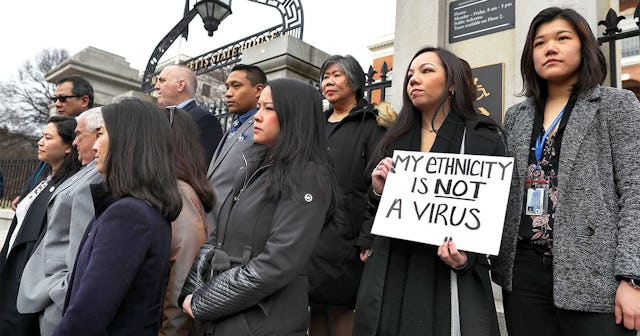The Asian and Black Communites Have Been Hit The Hardest By COVID-19

The Asian and Black communities have been adversely impacted by COVID-19. The shared struggle between these two groups can serve as the impetus for combatting the insidious racism faced by both communities during the pandemic.
When news first broke about COVID-19, an anti-Asian sentiment was both palpable and visible nationwide in American cities. Asian American communities faced questions about their citizenship or national origin, verbal macroaggressions and insults, and physical abuse. Federal officials fanned xenophobic and anti-Asian attacks by calling COVID-19 “the Wuhan virus” or “Kung Flu,” further othering a racial group that historically has been perceived as the “perpetual foreigner” in this country. These heinous actions confirm the fact that the Asian American community is navigating a pandemic fear that strips away at their dignity and identity.
Local residents Burnetta Kinsey (C) and Zina Parker (R) fill out paperwork at a mobile COVID-19 testing station in a public school parking area in Compton, California, just south of Los Angeles, on April 28, 2020. – St. John’s Well Child and Family Center is providing COVID-19 testing sites in African-American and Latino communities which have been neglected in terms of testing as compared to wealthier areas of Los Angeles County. Robyn Beck/Getty
Then, there is the Black community. Prior to released data, COVID-19 was the virus with no name attached to it. It was not associated with a race or socioeconomic status — some even dubbed it the virus that was the great equalizer, impacting every identity, community, and generation. However, once the infection and death rates of the virus were analyzed, we soon discovered that COVID-19 disproportionately affected the Black community.
According to the CDC, in major US cities such as Chicago and Milwaukee, Black people are less than a third of the population, but accounted for 70% of the deaths due to coronavirus. These disproportionate numbers reflect cumulative and systemic inequities, including that of housing segregation, gentrification, disparities in access to healthcare, food insecurity, and environmental racism.
Given our growing awareness of how intertwined the Asian and Black communities are, my work as a diversity practitioner has me thinking about what it means to show up in support of marginalized groups during this unprecedented time. I have been focused on the solidarity needed between the Asian and Black communities in order to counter the insidious racism and discrimination impacting both communities.
Members of the Asian American Commission hold a press conference on the steps of the Massachusetts State House to condemn racism towards the Asian American community because of coronavirus on March 12, 2020 in Boston. John Tlumacki/Getty
So, what does solidarity look like exactly? Well, for starters, it means coming together to speak out against social injustices impacting our respective communities. It will require us to have frank conversations with ourselves, our families, co-workers, friends, and sometimes, even strangers. It requires us to examine and interrupt stereotypes and tropes that divide rather than bring us together. We need to create spaces that will amplify our narratives, finding common ground in our shared experiences and humanity.
It means that as Black people, we need to continue to speak out when we see acts of “othering” and violence happening to the Asian community. We know what it feels like to be marginalized, so it is incumbent on us to speak up and speak out in the face of discrimination. To the Asian American community: I want to also challenge you to continue speaking out against racialized systemic injustices. Staying silent is a sign of complicity, one that perpetuates the status quo and benefits the dominant majority, which, in turn, hurts all people of color.
When both of our groups dismiss the assumption that our oppression is not inextricably related, we cannot realize our collective power, standing united, challenging the vitriol, discrimination, and racism that has plagued both of our communities for so many years.
COVID-19 is teaching us a lot about who we are, and who we want to be. We cannot be silent about the things that matter. When something happens to one of us, it impacts all of us.
Local resident Burnetta Kinsey describes her symptoms at a mobile COVID-19 testing station in a public school parking area in Compton, California, just south of Los Angeles, on April 28, 2020. – St. John’s Well Child and Family Center is providing COVID-19 testing sites in African-American and Latino communities which have been neglected in terms of testing as compared to wealthier areas of Los Angeles County. ROBYN BECK/Getty
Our respective histories have shown us that there has been an intentional wedge driven between our communities by the dominant majority. As a native Angeleno, I recall the discord of our communities during the unrest of 1992. Our communities were at odds with each other; feelings of distrust and anger erupted. Our communities have worked to repair and heal our relationships — a process that continues even now.
But what if this time, during the pandemic, we did things differently? What if this moment is a call to action? A time to come together, finding common ground, stand up for each other, speak out on the injustices that have recently surfaced for our communities. Our affinity and connectivity have never been more urgent.
COVID-19 is one of the biggest challenges we face, and our solidarity will create meaningful change as we battle the societal impacts of the coronavirus. There is beauty and strength in our mutual struggle; although apart, we are stronger together.
This article was originally published on